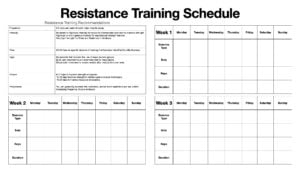The principles of training are what separates an average athlete from a champion.
These principles can be applied to any sport or activity, and they all have one thing in common: they increase the likelihood of success by enhancing performance while reducing risk for injury.
In this blog post we’ll go over the basics of how these principles can help you become a better athlete!
What’s the Training Principles?
These principles were made for a wide range of athletes, from beginner to elite. They work on everyone and are a good place to start for any athlete who wants to be better at their sport.
These principles can also be used with people who are starting their fitness/weight loss journey. Basically, if you’re working out you need to know these principles.
The main purpose of it is to create an environment that will allow an individual to improve their fitness level.
Overload:
If we’re not pushing ourselves enough in our workouts, then it won’t lead to any changes or adaptations – so the body will hit an eventual plateau.
That’s why you need to up the ante every few weeks: add a little more weight, reps or sets to your workout routine and see how it does for you!
Reversibility:
This principle means that for every action, there is a reaction. If you’ve been doing your workouts the same way over and over again – that’s going to lead to stagnation and hitting a plateau: it’s time to change things up!
Also, once the training stimulus is removed from a muscle group it will return back to its previous state unless there’s an overload placed on that same muscle again. This means that if you stop working out all the gains you’ve acquired will be lost.
To maintain gains in strength and size you should incorporate periods of rest into your program so the muscles have time to recover before they’re overloaded again.
Progression: This is when you gradually increase the intensity/volume of your training. One way to do this is by simply adding more reps or sets to your workouts.
Another way might be doing a lighter workout for longer periods of time – like working out 30 minutes each day rather than 15.
Individualization:
Individualization is when you design a workout plan for yourself and your goals. This is why it’s so important to know what motivates you and how much time you want to commit. The main point is to customize an exercise routine that will work best for you.
Periodization:
Periodization is when you change up your exercises at certain points in the year. It is mainly used by athletes to develop and identify their peak performance.
But just because you’re not a competitive athlete, it doesn’t mean this principle works for you.
Remember that weight loss plateau happens when your body gets used to your routines, so if you’re strategizing, periodizing, and organizing your workout plans then you’ll never hit a weight loss plateau.
The goal of periodizing is to provide adequate periods of training as well as rest so that the muscles can be both stimulated and allowed to recover before they’re overtrained.
For example, if you train on Monday through Friday each week then one program would look like this:
Monday: Pull Workout (Back and Biceps)
Tuesday: Push Workout (Chest, Triceps, Shoulders)
Wednesday- Rest or light cardio/speed work
Thursday: Legs and Core Workout
Friday- Rest or light cardio/speed work.
The weight on Monday is the most difficult because it’s the first time that the muscle group has been trained for a week.
I created a blog post about Workout Schedule and Splits, it might help you out.
Specificity:
Specificity is the key to success. If you want a tight butt, then isolate that muscle group and work it out for an extended period of time. If you want to lose weight, then you’ll do more cardio rather than bodybuilding workouts.
This principle is all about training for what you’re going to be doing. Are you running the marathon or just sprinting? Do you specialize in one sport, such as swimming, or do you have a diverse set of skills like boxing and wrestling?
The specificity principle dictates that if your goal is something specific then make sure you train for it.
Overtraining/Overstress
This is when a person’s body cannot recover from the workouts. It is imperative that you schedule a rest day and allow your muscles to heal. If you train day after day with no rest your body will eventually reach a point of overtraining and there’s not much that can be done in terms of recovery from this state.
You must have periods of time where you’re training to stimulate progress, but also allow the muscles adequate time to recover before they’re overloaded again.
It’s very important to recognize these signs in order to prevent them from happening.
So, what are the principles of training? They include things like practicing specific skills at high intensity, taking time to recover from workouts, and a balanced diet.
The principles of training are what separates an average athlete from a champion. These principles can be applied to any sport or activity, and they all have one thing in common: they increase the likelihood of success by enhancing performance while reducing the risk for injury.
Read more about them here on my blog!
If you’re looking for some motivation or want to know how other people got started doing their favorite sport (or activity), be sure to check out my other blogs too!







